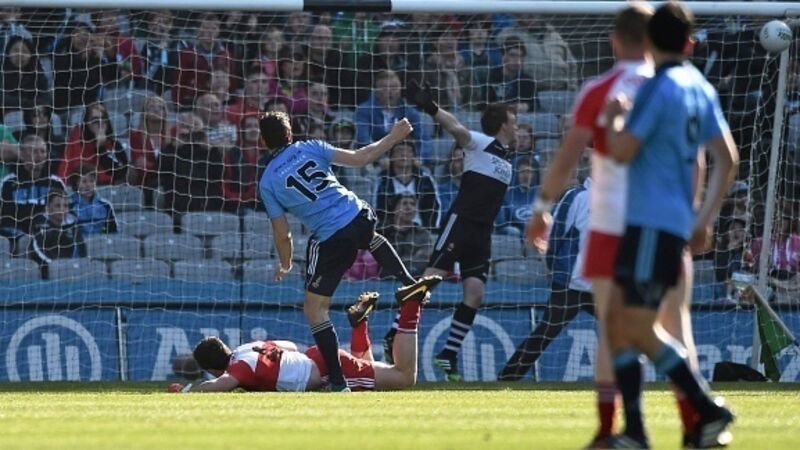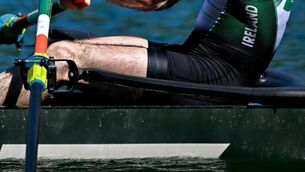The price of Dublin’s dominance

Anyone who has been on the famed terrace on a Sunday Championship afternoon will appreciate the send-up.
One of the best lines comes as the fan has grown bored of the game and addresses a friend: “Here, we’re all over these mulchies. C’mon, we’ll head back to Timmo’s for a few cans, get the end of United match.”
A certain element of Dublin’s following, so often blamed for turning up late to games, are now being lampooned for leaving early as their team wins with ease.
Satire only works when it hits upon a truth and Rory O’Connor, the man behind the sketch, has done just that. When Dublin are beating teams so handsomely, complacency is sure to set in.
All-Ireland finals and semi-finals and any Championship meeting with Kerry are one thing, but is the dominance of the All-Ireland champions liable to turn more of their supporters into event junkies?
Might they believe it’s in their interests to assume and save for bigger days out in August and September?
There’s plenty to justify that thought process in the statistics. Dublin have not lost an All-Ireland quarter-final since 2009. Going back to May 2005, they have been beaten in just one provincial game, the 2010 Leinster semi-final against Meath.
The other 26 fixtures, they have won. On most occasions, emphatically so. Last year, their average winning margin was an almost embarrassing 13 points. Over the course of the last nine Leinster campaigns, it levels out at eight points.
What is most worrying for the Leinster Council and the GAA this June and July is that the provincial draw might persuade their best moneymakers to stay at home.
Dublin face the winners of Laois and Wicklow in their quarter-final on June 8. Should they, as fully expected, progress they will play either Wexford, Longford or Offaly in a June 29 semi-final. Longford and Offaly were relegated from Division 3 this year. Wexford just about avoided the same drop. It won’t be until the final on July 20 that they can square up to Kildare and Meath and even at that they are both Division 2 material. The sight of a green and gold jersey will always stir Dublin but the appeal of facing the Lilywhites has lost some of its shine.
In each of the last three seasons, the three Leinster games Dublin have been involved in, including the quarter and semi-final double-headers, have attracted between 140,000 to just shy of 150,000.
Back in 2009, the 200,000 mark was surpassed for the trio of fixtures largely due to Meath and Kildare being on Dublin’s radar and regarded in the capital as veritable threats.
That pair of neighbours were present again last year but more so in the path of Dublin’s steamroller. By that stage the blue and navy throngs had sized them up as smaller fish and voted with their feet.
So what happens now that Dublin are so utterly ascendant in Leinster? Nobody will beat them playing at their own game and the new rules have formed a moat around them. That added level of protection should also mean they don’t have to resort to unseemly acts to save their hides as seen in the closing stages of last September’s final.
By no means are they a foregone conclusion to successfully defend their All-Ireland title but it will take something quite monumental to stop them.
Their supporters know that. Plenty of them believe pursuing such avenues of resistance are futile. To paraphrase the old refrain, when the Dubs go up to lift the Sam Maguire they will want to be there. However, until then it’s a matter of waiting but possibly more so in the wings than on Hill 16.
* john.fogarty@examiner.ie
Sunday’s Division 2 final threw up a number of contentious issues – such as Darren Hughes’ injury-time black card for a deliberate third man tackle.
In ways similar to Richie Feeney’s early one in the All-Ireland club final, the Monaghan man appeared to do nothing more than hold his ground.
That, according to his own county man and national referees committee chairman Pat McEnaney, does not warrant a black card.
As he said in the GAA’s official video explaining this year’s new football rules: “Any player is quite entitled to hold his own ground. But once he makes a step off that line to take another player’s line, to deliberately take him out of a game, that’s a black card offence.
“Once he takes a step right or left to take a player out of the game that’s a deliberate body-collide.”
The rule is extremely open to interpretation, no more so than the advantage the player who has released the ball may attain by running into the path of his opponent to hoodwink the referee.
With the start of the All-Ireland football championship upon us in five days, it would be to everyone’s benefit that a clarification is offered.
Twelve months on and it’s Kilkenny and Tipperary that again provide the entertainment in the hurling league’s showcase game — but so much has changed.
Were the counties to field the same starting line-ups as they did for the semi-finals, they would each show seven personnel alterations to their 2013 teams.
In different ways, last season taught the majesties of the game over the previous four seasons that they hadn’t moved with the times.
Kilkenny’s poor start to the league put them on the backfoot and they couldn’t give proper game-time to their up-and-comers, while the Tipperary management admitted their tactics were too similar to their 2010 approach.
Beating Kilkenny would complete a 180 degree transformation for Tipperary from where they were at one stage last month.
Last July, they were consumed by the arrogant belief among their own that Kilkenny were only waiting to be put out of their misery.
Just once in their last seven meetings have they actually beaten their neighbours. In this dance, they haven’t led but followed.












